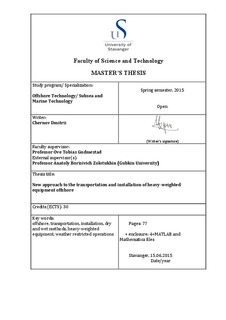| dc.description.abstract | Installation of offshore equipment is a huge branch of business in the oil and
gas industry. Almost every offshore project requires heavy-weighted equipment,
which should be installed on the seabed. Recently, oil and gas companies instead
of producing from platforms prefer to develop fields as subsea factories.
Mentioned changes result in growing opportunities for offshore service companies,
working in the field of transportation and installation, as the workload constantly
increases.
Currently, several techniques are used to carry out the full installation
activities. The most used one is to transport the equipment by a subsea construction
vessel (SSCV) and then transmit the equipment from the deck of the vessel to the
seabed by a vessel’s crane. Such approach requires to hire a costly vessel – SSCV
and have some limitations due to weather restrictions. Moreover, the most up to
date SSCV’s are not able to operate with cargo’s weights more than 500 tons. To
carry out the installation of heavy-weighted equipment, such as templates with
integrated manifold, two vessels – barge and heavy lift crane vessel should be
used. This leads to a significant increase in the installation cost.
However, service companies such as Subsea7, Aker, etc. have their own
technologies, which could be classified as “wet” transportation and installation
methods. Some of them already have practical applications. These methods have
several pros and cons that will be reviewed in the paper.
The main aim of this work is to develop technical concept of a new wet
transportation and installation approach, taking into account pros and cons of
existing methods, make some approximate estimations of the processes from
technical and economical points of view. Briefly, the idea is to implement
adjustable bouncy compensators (BC) in the process of offshore transportation and
installation of oil and gas equipment. Different equipment like subsea production
ii
systems, manifolds, templates and PLETs can be tooled up with a BC. This idea
will help to eliminate use of offshore cranes during the process of installation, thus
an enhanced operability and safety will be achieved due to elimination of the
connection between vessel and equipment. The described technology allows one to
carry out operations in harsh conditions with large wave height (with given level of
safety) and heavy weighted equipment as well. Suggested innovation can be used
in combination with other wet installation methods. | nb_NO |
